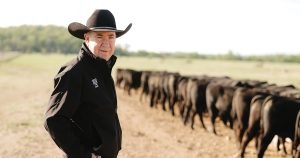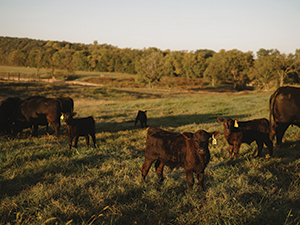The Supply Side: Ranch2Retail seeks to connect retailers with cattle supply chains
by September 23, 2024 3:18 pm 447 views

Rogers-based startup Ranch2Retail (R2R) is just what the name implies – a bridge between cattle ranchers and retailers who sell beef products and the supply chain that connects the two.
Co-founder Lamar Steiger is a rancher of Angus cattle dating back three generations, but he also worked with Walmart as a supply chain consultant in 2014 when the retail giant sought to upgrade its beef offering and shorten its supply chain. Walmart’s recent efforts to shorten its beef supply chain are proof that the market is ready for change, according to Steiger.
In 2019, Walmart invested more than $257 million in partnering with further processors and McClaren Farms to open its first case-ready beef plant in Georgia. Walmart launched an in-house Angus brand in stores across the Southeast. Walmart then invested in Sustainable Beef, a company founded by a group of ranchers to create a new outlet for processing and selling their cattle outside the traditional market.
Tyson Foods, Cargill, National Beef and JBS control as much as 75% of the beef cattle slaughtered for retail, according to the U.S. Department of Agriculture (USDA) and represent the traditional market. Last year, Walmart announced another packing plant in Olathe, Kan., that would supply its stores in the Midwest, bypassing traditional meatpackers.
Steiger said Walmart’s move to secure a quality beef supply chain is a smart one. Though he no longer consults with Walmart on its beef supply chain activities, he said retailers of all sizes want to offer higher-quality beef at a value, especially at times when beef prices are high. Having worked behind the retail curtain and in the beef cattle business, Steiger said R2R is equipped to help cattle ranchers align with retailers and shorten supply chains, which helps both groups.

“The existing model presents a wealth of opportunity for improvement. Today’s consumers demand to know more about where their food comes from, how animals are treated, and that they can count on their grocer to provide high-quality products at a value. One segment of the beef supply chain can’t solve it all,” said Steiger. “Our vision for Ranch2Retail is to create a well-designed, organized, collaborative supply chain. When that happens, the customer wins, and we’re creating repeat business, so we can all be profitable together.”
CREATING CONNECTIONS
Steiger said the R2R model uses technology, cooperation and relationships in every industry segment, from seed stock to feedlot and packer to retailers, to better serve consumers and reduce price volatility. As the final link in the value chain, supermarket grocers need beef supply partners that can build resiliency and consistency. He said R2R establishes digital cooperation to help knowledge sharing, identify efficiencies, and ensure that supply chain partners can build the needed resiliency and consistency.
With the beef cattle herd at low levels not seen since the late 1950s and ranchers wanting additional markets for their cattle, Steiger said retail chains also want to shore up their supply and cut costs. Given the fractured nature of the beef supply chain, cow-calf ranches in Arkansas and around the country are typically four or five links away from the consumer buying steaks or roasts at their local grocery store. Packers like Tyson Foods sit in the middle of the supply chain and procure the cattle they slaughter by contract. Then they process the cuts to suit their customers, which are primarily retailers and restaurants. He said cow-calf ranchers and consumers have largely not been consulted about their wants and needs.

Steiger said R2R, which includes co-founder and CEO Doug Batie and General Manager Neil Mellers, continues to engage with cow-calf operators, stockers, and feedlot partners while also seeking interest from retailers and packers. Batie and Mellers combine 40 years of retail-consumer packaged goods experience. Batie is also a rancher, and Mellers is a data miner for consumer/shopper behaviors.
BEEF SALES
Steiger said regional grocers are closer to the consumer and understand how important value is amid persistently high food prices. Despite near-record high steak prices this summer selling more than $10 per pound and hamburger around $5 per pound, consumer demand has been resilient.
The National Cattlemen’s Beef Association reports beef consumption has been solid this summer, even amid higher prices. The trade group said 72% of consumers say they eat beef each week, which was second only to chicken at 84%. Nielsen reports beef sales rose 6.9% in August, while pounds produced were up 0.6% from a year ago. Chicken sales rose 2.8%, with production up 2% in August compared to a year ago.
Steiger said the live cattle herd available for slaughter remains tight, and there is no evidence of heifer retention, which is needed to boost herd sizes. Cattle ranchers retain heifers or female cows they intend to breed, but more cows have been going to slaughter through the summer, indicating no signs of a herd rebuild. Once heifers are retained and bred, it takes another two years before the calf is old enough to sell.
Cattle prices are going to remain high simply because of supply and demand. Sterling Profit Tracker estimates cow-calf margins will average $536 per cow this year, better than a year ago. However, with higher interest rates, most ranchers are not interested in borrowing to expand their herd, Sterling said.
Steiger said the industry is poised to see changes as live herd numbers continue to decrease and retailers seek assurance of their supply chain. He said that by working directly with producers, retailers can better control the quality of the beef they sell, which could be what is fed, how much stress the animals are under, and any medications they are given. He said packers also have to be open to a collaborative supply chain or they could risk losing share to more retailer-cattlemen partnerships like those by Walmart.
Derrell Peel, livestock marketing analyst at Oklahoma State University Extension, said the beef supply chain is perhaps the most complex of any other. He said as many as 25,000 different products are made from a slaughtered cow. He said there is plenty of demand for the higher quality middle meats – steaks and higher margin cuts – or fat and trim that goes into hamburgers, but that is just a fraction of the whole animal.
“I am not saying matching retailers to a particular ranch co-op with a further-processing partner won’t work on a small scale. But someone has to be able to market the other parts, and that is no easy feat,” Peel said.
Editor’s note: The Supply Side section of Talk Business & Politics focuses on the companies, organizations, issues and individuals engaged in providing products and services to retailers. The Supply Side is managed by Talk Business & Politics and sponsored by Firebend.
